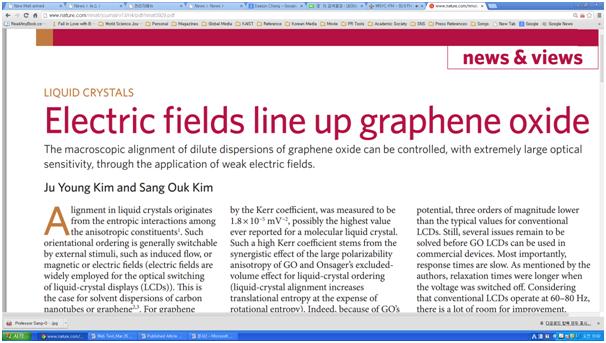people
Nature Materials, a
peer-reviewed scientific journal published by Nature Publishing Group, covers a
range of topics within materials science from materials engineering and
structural materials.
The
journal invited Professor Sang-Ouk Kim of Materials Science and Engineering at
KAIST to contribute to the April issue of 2014. Professor Kim,
together with his doctoral student, Ju-Young Kim, wrote a review article in the
“News and Views” section of the journal, which was entitled “Liquid Crystals:
Electric Fields Line Up Graphene Oxide.”
The
News and Views is a peer-reviewed section where an academic authority in a particular
field reviews and evaluates papers published in the journal.
In
the article, Professor Kim reviewed a paper written by Jang-Kun Song et al. and
highlighted important research outcomes such as the efficient electric field switching
of graphene oxide (GO) liquid-crystals in low-concentration dispersions and the
demonstration of a prototype of a GO liquid-crystal display. This technology
could lead the development of a flexible display.
Professor Kim is an eminent scholar who has reported for the first time in the world on the solvent-based graphene oxide liquid crystals formation in 2011.
For the article, please go to:

-
research A Hole in One for Holographic Display
(Professor YongKeun Park) Researchers have designed an ultrathin display that can project dynamic, multi-coloured, 3D holographic images, according to a study published in Nature Communications. The system’s critical component is a thin film of titanium filled with tiny holes that precisely correspond with each pixel in a liquid crystal display (LCD) panel. This film acts as a ‘photon sieve’ – each pinhole diffracts light emerging from them widely, resulting in a
2019-04-18 -
research Unravelling Inherent Electrocatalysis to Improve the Performance of Hydrogen Fuel Cells
(Figure 1. Electrode structure for the precise evaluation of the metal nanoparticles’ electrochemical catalytic characteristics at a high temperature.) A KAIST team presented an ideal electrode design to enhance the performance of high-temperature fuel cells. The new analytical platform with advanced nanoscale patterning method quantitatively revealed the electrochemical value of metal nanoparticles dispersed on the oxide electrode, thus leading to electrode design directions that c
2019-03-28 -
research New Catalyst for Synthesizing Chiral Molecules Selectively
(from left: Dr. Yoonsu Park and Professor Sukbok Chang from the Department of Chemistry) Molecules in nature often have “twin” molecules that look identical. In particular, the twin molecules that look like mirror images to each other are called enantiomers. However, even though they have the same type and number of elements, these twin molecules exhibit completely different properties. Professor Sukbok Chang and Dr. Yoonsu Park from the Department of Chemistry
2019-03-05 -
research New LSB with Theoretical Capacity over 90%
(Professor Hee-Tak Kim and Hyunwon Chu) A KAIST research team has developed a lithium sulfur battery (LSB) that realizes 92% of the theoretical capacity and an areal capacity of 4mAh/cm2. LSBs are gaining a great deal of attention as an alternative for lithium ion batteries (LIBs) because they have a theoretical energy density up to six to seven times higher than that of LIBs, and can be manufactured in a more cost-effective way. However, LSBs face the obstacle of
2019-02-11 -
research Noninvasive Light-Sensitive Recombinase for Deep Brain Genetic Manipulation
A KAIST team presented a noninvasive light-sensitive photoactivatable recombinase suitable for genetic manipulation in vivo. The highly light-sensitive property of photoactivatable Flp recombinase will be ideal for controlling genetic manipulation in deep mouse brain regions by illumination with a noninvasive light-emitting diode. This easy-to-use optogenetic module made by Professor Won Do Heo and his team will provide a side-effect free and expandable genetic manipulation tool for neurosci
2019-01-22